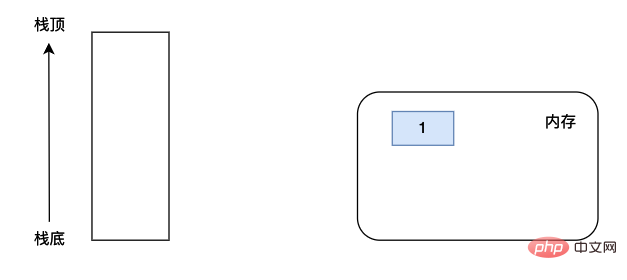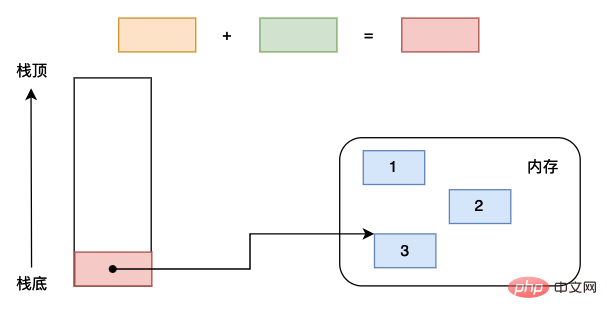 Backend Development
Backend Development
 Python Tutorial
Python Tutorial
 What is the role of Code obejct in the Python virtual machine?
What is the role of Code obejct in the Python virtual machine?
What is the role of Code obejct in the Python virtual machine?
Code Object data structure
typedef struct {
PyObject_HEAD
int co_argcount; /* #arguments, except *args */
int co_kwonlyargcount; /* #keyword only arguments */
int co_nlocals; /* #local variables */
int co_stacksize; /* #entries needed for evaluation stack */
int co_flags; /* CO_..., see below */
PyObject *co_code; /* instruction opcodes */
PyObject *co_consts; /* list (constants used) */
PyObject *co_names; /* list of strings (names used) */
PyObject *co_varnames; /* tuple of strings (local variable names) */
PyObject *co_freevars; /* tuple of strings (free variable names) */
PyObject *co_cellvars; /* tuple of strings (cell variable names) */
/* The rest aren't used in either hash or comparisons, except for
co_name (used in both) and co_firstlineno (used only in
comparisons). This is done to preserve the name and line number
for tracebacks and debuggers; otherwise, constant de-duplication
would collapse identical functions/lambdas defined on different lines.
*/
unsigned char *co_cell2arg; /* Maps cell vars which are arguments. */
PyObject *co_filename; /* unicode (where it was loaded from) */
PyObject *co_name; /* unicode (name, for reference) */
int co_firstlineno; /* first source line number */
PyObject *co_lnotab; /* string (encoding addr<->lineno mapping) See
Objects/lnotab_notes.txt for details. */
void *co_zombieframe; /* for optimization only (see frameobject.c) */
PyObject *co_weakreflist; /* to support weakrefs to code objects */
} PyCodeObject;The following is the role of each field in the code object:
First of all, you need to understand the concept of code block. The so-called code block is a Small python code is executed as a small unit. Common code blocks in python include: function body, class definition, and a module.
argcount, this represents the number of parameters in a code block. This parameter is only useful for function body code blocks, because the function may have parameters. For example, the above pycdemo.py is a module Rather than a function, the corresponding value of this parameter is 0.
co_code, the specific content of this object is a byte sequence, which stores the real python bytecode. It is mainly used for python virtual machine execution and will not be included in this article for the time being. Detailed analysis.
co_consts, this field is a list type field, mainly containing some string constants and numerical constants, such as "__main__" and 100 above.
co_filename, the meaning of this field is the file name of the corresponding source file.
co_firstlineno, the meaning of this field is the number of lines that appears in the first line of code in the python source file. This field is very important when debugging.
co_flags, the main meaning of this field is to identify the type of this code object. 0x0080 indicates that this block is a coroutine, 0x0010 indicates that this code object is nested, etc.
co_lnotab, the meaning of this field is mainly used to calculate the number of source code lines corresponding to each bytecode instruction.
co_varnames, the main meaning of this field is to represent a name defined locally in a code object.
co_names, the opposite of co_varnames, represents names that are not locally defined but used in the code object.
co_nlocals, this field indicates the number of variables used locally in a code object.
co_stackszie, because the Python virtual machine is a stack computer, the value of this parameter indicates the maximum value required for this stack.
co_cellvars, co_freevars, these two fields are mainly related to nested functions and function closures. We will explain this field in detail in subsequent articles.
CodeObject Detailed Analysis
Now we use some practical examples to analyze specific code objects.
import dis
import binascii
import types
d = 10
def test_co01(c):
a = 1
b = 2
return a + b + c + dIn the previous article we mentioned that a function includes a code object object. The output result of the code object object of test_co01 (see co01 for the complete code) is as follows:
code
argcount 1
nlocals 3
stacksize 2
flags 0043 0x43
code b'6401007d01006402007d02007c01007c0200177c0000177400001753'
9 0 LOAD_CONST 1 (1)
3 STORE_FAST 1 (a)
10 6 LOAD_CONST 2 (2)
9 STORE_FAST 2 (b)
11 12 LOAD_FAST 1 (a)
15 LOAD_FAST 2 (b)
18 BINARY_ADD
19 LOAD_FAST 0 (c)
22 BINARY_ADD
23 LOAD_GLOBAL 0 (d)
26 BINARY_ADD
27 RETURN_VALUE
consts
None
1
2
names ('d',)
varnames ('c', 'a', 'b')
freevars ()
cellvars ()
filename '/tmp/pycharm_project_396/co01.py'
name 'test_co01'
firstlineno 8
lnotab b'000106010601'The value of the field argcount is equal to 1, indicating that the function has one parameter. This function test_co01 has a parameter c that corresponds to each other.
The value of field nlocals is equal to 3, indicating that a total of three function local variables a, b, c are implemented in function test_co01.
The field names corresponds to co_names in the code. According to the previous definition, the global variable d is used in the function test_co01, but it is not defined in the function.
Field varnames, this represents the variables used in local definitions. There are three main variables a, b, c in the function test_co01.
The field filename is the address of the python file.
Field firstlineno indicates that the first line of the function appears on line 8 of the corresponding python code.
Flags field detailed analysis
We specifically use the source code of python3.5 for analysis. The specific implementation of the cpython virtual machine is as follows (Include/code.h ):
/* Masks for co_flags above */ #define CO_OPTIMIZED 0x0001 #define CO_NEWLOCALS 0x0002 #define CO_VARARGS 0x0004 #define CO_VARKEYWORDS 0x0008 #define CO_NESTED 0x0010 #define CO_GENERATOR 0x0020 /* The CO_NOFREE flag is set if there are no free or cell variables. This information is redundant, but it allows a single flag test to determine whether there is any extra work to be done when the call frame it setup. */ #define CO_NOFREE 0x0040 /* The CO_COROUTINE flag is set for coroutine functions (defined with ``async def`` keywords) */ #define CO_COROUTINE 0x0080 #define CO_ITERABLE_COROUTINE 0x0100
If the & operation is performed between the flags field and each macro definition above, and if the result is greater than 0, it means that the corresponding conditions are met.
The meaning of the above macro definition is as follows:
CO_OPTIMIZED, this field indicates that the code object is optimized, using function local defined variables.
CO_NEWLOCALS, the meaning of this field is that when the code of this code object is executed, a dict object will be created for the f_locals object in the stack frame.
CO_VARARGS, indicates whether this code object contains positional parameters.
CO_VARKEYWORDS, indicates whether this code object contains keyword parameters.
CO_NESTED, indicating that this code object is a nested function.
CO_GENERATOR, indicating that this code object is a generator.
CO_COROUTINE, indicating that this code object is a coroutine function.
CO_ITERABLE_COROUTINE, indicating that the code object is an iterable coroutine function.
CO_NOFREE, this means there are no freevars and cellvars, that is, there is no function closure.
Now let’s analyze the flags of the previous function test_co01. Its corresponding value is equal to 0x43, which means that this function satisfies three characteristics: CO_NEWLOCALS, CO_OPTIMIZED and CO_NOFREE.
freevars & cellvars
我们使用下面的函数来对这两个字段进行分析:
def test_co02():
a = 1
b = 2
def g():
return a + b
return a + b + g()上面的函数的信息如下所示(完整代码见co02):
code
argcount 0
nlocals 1
stacksize 3
flags 0003 0x3
code
b'640100890000640200890100870000870100660200640300640400860000'
b'7d0000880000880100177c00008300001753'
15 0 LOAD_CONST 1 (1)
3 STORE_DEREF 0 (a)
16 6 LOAD_CONST 2 (2)
9 STORE_DEREF 1 (b)
18 12 LOAD_CLOSURE 0 (a)
15 LOAD_CLOSURE 1 (b)
18 BUILD_TUPLE 2
21 LOAD_CONST 3 (<code object g at 0x7f133ff496f0, file "/tmp/pycharm_project_396/co01.py", line 18>)
24 LOAD_CONST 4 ('test_co02.<locals>.g')
27 MAKE_CLOSURE 0
30 STORE_FAST 0 (g)
20 33 LOAD_DEREF 0 (a)
36 LOAD_DEREF 1 (b)
39 BINARY_ADD
40 LOAD_FAST 0 (g)
43 CALL_FUNCTION 0 (0 positional, 0 keyword pair)
46 BINARY_ADD
47 RETURN_VALUE
consts
None
1
2
code
argcount 0
nlocals 0
stacksize 2
flags 0013 0x13
code b'8800008801001753'
19 0 LOAD_DEREF 0 (a)
3 LOAD_DEREF 1 (b)
6 BINARY_ADD
7 RETURN_VALUE
consts
None
names ()
varnames ()
freevars ('a', 'b')
cellvars ()
filename '/tmp/pycharm_project_396/co01.py'
name 'g'
firstlineno 18
lnotab b'0001'
'test_co02.<locals>.g'
names ()
varnames ('g',)
freevars ()
cellvars ('a', 'b')
filename '/tmp/pycharm_project_396/co01.py'
name 'test_co02'
firstlineno 14
lnotab b'0001060106021502'从上面的输出我们可以看到的是,函数 test_co02 的 cellvars 为 ('a', 'b'),函数 g 的 freevars 为 ('a', 'b'),cellvars 表示在其他函数当中会使用本地定义的变量,freevars 表示本地会使用其他函数定义的变量。
再来分析一下函数 test_co02 的 flags,他的 flags 等于 0x3 因为有闭包的存在因此 flags 不会存在 CO_NOFREE,也就是少了值 0x0040 。
stacksize
这个字段存储的是在函数在被虚拟机执行的时候所需要的最大的栈空间的大小,这也是一种优化手段,因为在知道所需要的最大的栈空间,所以可以在函数执行的时候直接分配指定大小的空间不需要在函数执行的时候再去重新扩容。
def test_stack():
a = 1
b = 2
return a + b上面的代码相关字节码等信息如下所示:
code
argcount 0
nlocals 2
stacksize 2
flags 0043 0x43
code b'6401007d00006402007d01007c00007c01001753'
# 字节码指令 # 字节码指令参数 # 参数对应的值
24 0 LOAD_CONST 1 (1)
3 STORE_FAST 0 (a)
25 6 LOAD_CONST 2 (2)
9 STORE_FAST 1 (b)
26 12 LOAD_FAST 0 (a)
15 LOAD_FAST 1 (b)
18 BINARY_ADD
19 RETURN_VALUE
consts
None # 下标等于 0 的常量
1 # 下标等于 1 的常量
2 # 下标等于 2 的常量
names ()
varnames ('a', 'b')
freevars ()
cellvars ()我们现在来模拟一下执行过程,在模拟之前我们首先来了解一下上面几条字节码的作用:
LOAD_CONST,将常量表当中的下标等于 i 个对象加载到栈当中,对应上面的代码 LOAD_CONST 的参数 i = 1。因此加载测常量等于 1 。因此现在栈空间如下所示:

STORE_FAST,将栈顶元素弹出并且保存到 co_varnames 对应的下标当中,根据上面的字节码参数等于 0 ,因此将 1 保存到 co_varnames[0] 对应的对象当中。

LOAD_CONST,将下标等于 2 的常量加载进入栈中。

STORE_FAST,将栈顶元素弹出,并且保存到 varnames 下标为 1 的对象。

LOAD_FAST,是取出 co_varnames 对应下标的数据,并且将其压入栈中。我们直接连续执行两个 LOAD_FAST 之后栈空间的布局如下:

BINARY_ADD,这个字节码指令是将栈空间的两个栈顶元素弹出,然后将两个数据进行相加操作,然后将相加得到的结果重新压入栈中。

RETURN_VALUE,将栈顶元素弹出并且作为返回值返回。
从上面的整个执行过程来看整个栈空间使用的最大的空间长度为 2 ,因此 stacksize = 2 。
The above is the detailed content of What is the role of Code obejct in the Python virtual machine?. For more information, please follow other related articles on the PHP Chinese website!

Hot AI Tools

Undresser.AI Undress
AI-powered app for creating realistic nude photos

AI Clothes Remover
Online AI tool for removing clothes from photos.

Undress AI Tool
Undress images for free

Clothoff.io
AI clothes remover

AI Hentai Generator
Generate AI Hentai for free.

Hot Article

Hot Tools

Notepad++7.3.1
Easy-to-use and free code editor

SublimeText3 Chinese version
Chinese version, very easy to use

Zend Studio 13.0.1
Powerful PHP integrated development environment

Dreamweaver CS6
Visual web development tools

SublimeText3 Mac version
God-level code editing software (SublimeText3)

Hot Topics
 1378
1378
 52
52
 How to use Debian Apache logs to improve website performance
Apr 12, 2025 pm 11:36 PM
How to use Debian Apache logs to improve website performance
Apr 12, 2025 pm 11:36 PM
This article will explain how to improve website performance by analyzing Apache logs under the Debian system. 1. Log Analysis Basics Apache log records the detailed information of all HTTP requests, including IP address, timestamp, request URL, HTTP method and response code. In Debian systems, these logs are usually located in the /var/log/apache2/access.log and /var/log/apache2/error.log directories. Understanding the log structure is the first step in effective analysis. 2. Log analysis tool You can use a variety of tools to analyze Apache logs: Command line tools: grep, awk, sed and other command line tools.
 Python: Games, GUIs, and More
Apr 13, 2025 am 12:14 AM
Python: Games, GUIs, and More
Apr 13, 2025 am 12:14 AM
Python excels in gaming and GUI development. 1) Game development uses Pygame, providing drawing, audio and other functions, which are suitable for creating 2D games. 2) GUI development can choose Tkinter or PyQt. Tkinter is simple and easy to use, PyQt has rich functions and is suitable for professional development.
 PHP and Python: Comparing Two Popular Programming Languages
Apr 14, 2025 am 12:13 AM
PHP and Python: Comparing Two Popular Programming Languages
Apr 14, 2025 am 12:13 AM
PHP and Python each have their own advantages, and choose according to project requirements. 1.PHP is suitable for web development, especially for rapid development and maintenance of websites. 2. Python is suitable for data science, machine learning and artificial intelligence, with concise syntax and suitable for beginners.
 How debian readdir integrates with other tools
Apr 13, 2025 am 09:42 AM
How debian readdir integrates with other tools
Apr 13, 2025 am 09:42 AM
The readdir function in the Debian system is a system call used to read directory contents and is often used in C programming. This article will explain how to integrate readdir with other tools to enhance its functionality. Method 1: Combining C language program and pipeline First, write a C program to call the readdir function and output the result: #include#include#include#includeintmain(intargc,char*argv[]){DIR*dir;structdirent*entry;if(argc!=2){
 The role of Debian Sniffer in DDoS attack detection
Apr 12, 2025 pm 10:42 PM
The role of Debian Sniffer in DDoS attack detection
Apr 12, 2025 pm 10:42 PM
This article discusses the DDoS attack detection method. Although no direct application case of "DebianSniffer" was found, the following methods can be used for DDoS attack detection: Effective DDoS attack detection technology: Detection based on traffic analysis: identifying DDoS attacks by monitoring abnormal patterns of network traffic, such as sudden traffic growth, surge in connections on specific ports, etc. This can be achieved using a variety of tools, including but not limited to professional network monitoring systems and custom scripts. For example, Python scripts combined with pyshark and colorama libraries can monitor network traffic in real time and issue alerts. Detection based on statistical analysis: By analyzing statistical characteristics of network traffic, such as data
 Python and Time: Making the Most of Your Study Time
Apr 14, 2025 am 12:02 AM
Python and Time: Making the Most of Your Study Time
Apr 14, 2025 am 12:02 AM
To maximize the efficiency of learning Python in a limited time, you can use Python's datetime, time, and schedule modules. 1. The datetime module is used to record and plan learning time. 2. The time module helps to set study and rest time. 3. The schedule module automatically arranges weekly learning tasks.
 Nginx SSL Certificate Update Debian Tutorial
Apr 13, 2025 am 07:21 AM
Nginx SSL Certificate Update Debian Tutorial
Apr 13, 2025 am 07:21 AM
This article will guide you on how to update your NginxSSL certificate on your Debian system. Step 1: Install Certbot First, make sure your system has certbot and python3-certbot-nginx packages installed. If not installed, please execute the following command: sudoapt-getupdatesudoapt-getinstallcertbotpython3-certbot-nginx Step 2: Obtain and configure the certificate Use the certbot command to obtain the Let'sEncrypt certificate and configure Nginx: sudocertbot--nginx Follow the prompts to select
 How to configure HTTPS server in Debian OpenSSL
Apr 13, 2025 am 11:03 AM
How to configure HTTPS server in Debian OpenSSL
Apr 13, 2025 am 11:03 AM
Configuring an HTTPS server on a Debian system involves several steps, including installing the necessary software, generating an SSL certificate, and configuring a web server (such as Apache or Nginx) to use an SSL certificate. Here is a basic guide, assuming you are using an ApacheWeb server. 1. Install the necessary software First, make sure your system is up to date and install Apache and OpenSSL: sudoaptupdatesudoaptupgradesudoaptinsta



